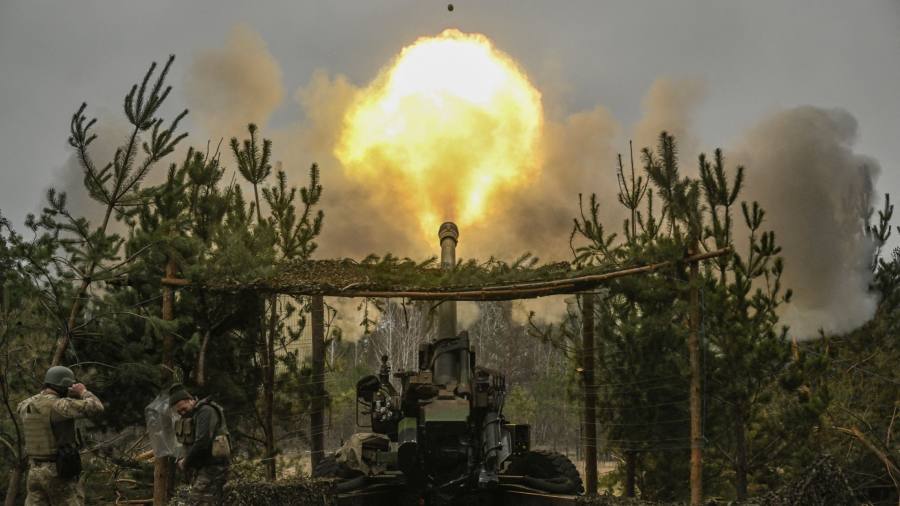
The Biden administration is seeking to increase stretched supplies of crucial munitions for Ukraine to support the counteroffensive against Russian occupying forces.
The weapons effort is focused on delivering more 155mm calibre shells used in the howitzers Ukraine is deploying along the front line, officials said, and includes supplies from international allies in the short term and plans to ramp up US production in the next two years.
“I personally sit in my office every morning and spend 30 minutes on 155[mm] ammunition,” US national security adviser Jake Sullivan said last month at the Aspen Security Forum.
Officials said the Biden administration had been aware for months that Ukraine’s high burn-rate of munitions would begin to stretch supplies and had stepped up efforts to get the shells to the front line as the war entered a crucial phase. European supplies have also become stretched, and the Financial Times reported last week that Ukraine had begun firing rockets made in North Korea.
“We are actively working as rapidly as possible to build out the production lines for 155,” Sullivan said. “We do not want to lose a day and there is not a tool, authority or dollar that we’re going to set on the sidelines to not being able to do that.”
The US has already struck deals with Bulgaria and South Korea to supply the shells to Ukraine and is in talks with Japan to do the same, officials said.
But a US Army effort to increase monthly output of the crucial munitions to 90,000 will take until 2025, highlighting the challenge of ramping up such production quickly, particularly when the US had not previously been focused on it.
“Prior to the Ukraine spin-up, most of the army’s focus was on building out new tank munitions,” said Retired Brig. Gen. Guy Walsh, executive vice-president at the National Defense Industrial Association.
The Pentagon has asked to buy only about 790,000 155mm rounds over the past 10 years, mostly for use in training exercises. That suggests the US has already given Ukraine more than the quantity it procured in 155mm purchases over the past decade, according to a report by the Center for a New American Security think-tank in Washington.
Compounding the effort to ramp up production was a US decision to downsize its defence industrial base after the cold war.
“We did not anticipate or prepare for a long war and the industrial base was constrained for efficiency,” said Mark Cancian, senior adviser at Washington’s Center for Strategic and International Studies
The munitions effort by the US and its allies comes as Ukraine intensifies its weeks-old counteroffensive in the south and east of the country. On Thursday and Friday, Kyiv said it had recaptured Staromaiorske, a village in south-eastern Donetsk region that had been under Russian occupation since early in the full-scale invasion.
Artillery warfare has dominated much of the fighting on the front line, with both sides firing thousands of shells each day.
The dearth of US supplies of 155mn shells to support the current push was an important driver behind President Joe Biden’s controversial decision last month to authorise shipments of cluster munitions to Ukraine.
The decision “helped ensure that Ukraine has the ammunition it needs and that they would not run out”, one US official said.
“We’re at the point where they’re supplying Ukraine at the level they can, and they’ve given them as much as they can, while keeping the reserves that they think are important to have in case there were an unforeseen crisis,” said Stacie Pettyjohn, director of the Defence Program at CNAS.
Ukrainian leaders have continually called on western allies to increase weapons supply, from air defence systems to fighter jets, as the country comes under pressure from international partners to speed up the counteroffensive.
Volodymyr Zelenskyy, Ukraine’s president, said last week that the effort got off to a slower start than hoped because “we had not enough munitions and armaments and not enough brigades properly trained in these weapons”.
The US and its international allies have so far trained 66,000 Ukrainian forces, according to Col. Martin O’Donnell, spokesman for US Army Europe and Africa. The US has committed more than $43bn in lethal assistance, including 198 155mm Howitzers as well as more than 2mn rounds for them.
“Ukraine is well prepared and well trained to be successful,” US defence secretary Lloyd Austin said last week.
But that has not diminished the need for the 155mn shells — the large steel bullets filled with explosives that weigh approximately 100 pounds and are fired from howitzer artillery systems, including American-made M777 and M109 weapons provided to Kyiv.
Ukraine is currently firing up to 8,000 rounds of artillery a day, a much larger quantity than the US would fire, according to American officials.
“As the front lines stabilise, the importance of artillery increases,” Cancian said. “The surprise has been how important just regular artillery shells are.”
The US is now also working to ramp up supply of the shells, with a target of producing up to 90,000 a month by fiscal year 2025, according to the US Army, compared with 24,000 now and 14,000 per month before Russia’s full-scale invasion of Ukraine.
However, production takes place mainly at four government-owned, contractor-operated sites in Pennsylvania, Tennessee, Virginia and Iowa. A report by CNAS described the effort as “a lean production process with multiple bottlenecks”.
The US Army is building more production lines, including retooling a facility in Ontario, Canada, and erecting a new assembly line in Texas. Army officials have said they may also establish new facilities to load, assemble and pack 155mm shells in Arkansas, Iowa and Kansas.
“President Biden has said he is committed to supporting Ukraine as long as it takes,” the US National Security Council said.